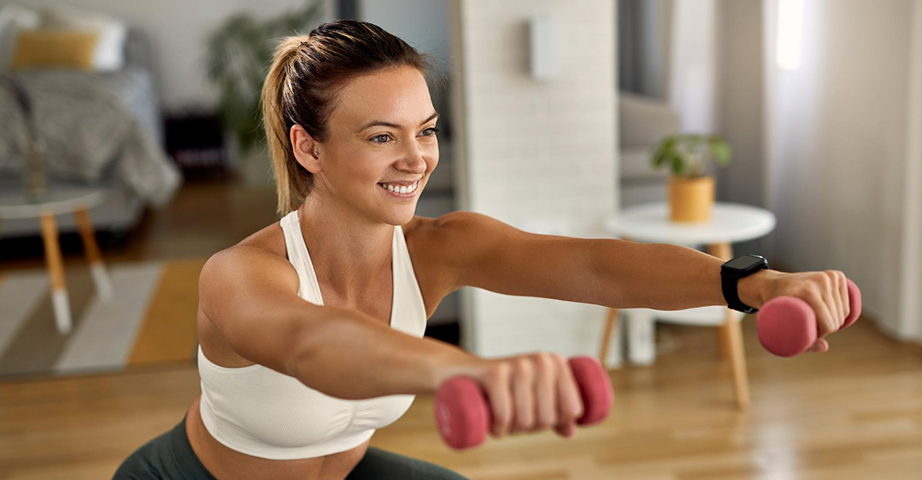Strength training at home - build your muscles without the gym

Strength training is what most of us associate with the gym. With machines, or at least a barbell and a bench. However, this is not the only option, and strength training at home is totally possible. For beginners, those losing weight and those treating strength training as an addition to other activities, training at home can be an ideal solution.
Do you need equipment for strength training at home? Where do I get my exercise inspiration from? What results can you expect? We explain everything you need to know before you begin the adventure of strength training at home.
Strength training at home - is it possible?
Strength means weights, and machines. This is how we associate muscle development and strength gains. In fact, muscles need a stimulus in the form of a load in order to grow. However, this stimulus does not have to come from a professional machine. A sufficient load for beginners and those for whom strength training is a complement to other activities, rather than a way to build muscle mass, is their own body weight. Yes, your body, properly used, is a load during strength training.
Over time as muscle strength and endurance increase, body weight itself becomes too weak to stimulate muscle development. Especially if the training goal is to build an athletic physique. Then, it becomes necessary to use equipment and much heavier weights. However, before we get to this stage, we can safely organise strength training at home.
To begin strength training at home, all you need is a free space large enough to lie down with arms outstretched to the sides and a place to stretch your arms behind your head. It is important not to get caught on anything while exercising - not to damage yourself or the equipment in your home. For strength training at home things that everyone has at home will come in handy - a chair, bottles or a water jug. If we don't have a soft carpet, it's worth investing in a mat so that exercising is more comfortable and the neighbours hear us less. It will be enough for a good start
Who is strength training at home for?
Strength training at home can be an option for many people. In fact, there are many reasons why we choose to exercise at home. We don't want to spend money on a membership. The gym is far away. We don't have time to get there, get ready, and then get changed. We don't have someone to leave the children with. We don't like exercising with others. We want to see if we enjoy weight training at all. And much, much more. Fortunately, all of these things don't rule out strength training.
Strength training at home will benefit the most:
- beginners who have no experience with weights and whose muscles have little endurance.
- people losing weight - strength training during weight loss is a must to prevent the muscle mass loss typical of low-calorie diets. Strength training alone has a slimming effect. Although during strength training alone the amount of calories burned is less than during cardio, the effect of increased energy consumption persists for several hours after strength training, and with cardio it disappears immediately after exercise.
- endurance trainers - in order to avoid the overly lean, flabby physique that often appears in endurance sports, specialists recommend at least one strength training session per week.
Recommended products
Effects of strength training at home
Strength exercises performed at home are very good for both the figure and health. The effects depend, of course, on the amount and intensity of training. People with a sedentary lifestyle, for whom strength training at home is the only activity, can train up to 4-5 times a week, as long as they do not overload their muscles, of course. When strength training is in addition to other exercises, it is worth doing 1-3 times a week.
After strength training at home, you can expect:
- improved fitness - better cardiovascular and respiratory function,
- strengthening of bones and joints,
- increased strength, endurance and muscle mass,
- accelerated effects of a weight-loss diet,
- a strong, firm body,
- improved immunity,
- improved mood after training and better well-being in general.
Strength exercises at home - with or without equipment?
Strength training at home can be done without equipment. Especially in the first weeks of training, when the body is just getting used to it and the muscles are gradually gaining strength and endurance, your own body weight is sufficient. In addition, there are exercises such as push-ups, planks or tummy tucks which, through various modifications, can be made more difficult as the body becomes accustomed to the stimulus.
Over time, it turns out that the body weight is not enough to stimulate the muscles to develop. At that point, it is worth reaching for two of the simplest accessories that make strength training at home much more challenging. These are dumbbells and resistance bands..
It is best to invest in dumbbells or, in other words, barbells with removable plates of different weights. It will make it easy to match the load to your capabilities and there will be no need to buy new, heavier dumbbells when progressing. Dumbbells are an additional resistance stimulus for a huge number of exercises, not only those for arms, shoulders and chest. With dumbbells you can perform squats, trunk lunges, short, dynamic jumping jacks or various types of tummy tucks..
The same exercises, with resistance bands, require much more effort from the muscles than those performed without equipment. The resistance can be adjusted and gradually increased by choosing thicker and less stretchy bands. Adding resistance bands to your workout will make it harder to perform strength exercises at home such as squats, lying hip raises, clamshell, side walk, leg inversions, stretches, arm raises and bends as well as push-ups... Resistance bands offer plenty of opportunities for use in strength training at home.

Strength training at home - don't forget about the warm-up
Every workout, including strength training at home, should start with a warm-up. The warm-up prepares the muscles and joints for a greater effort, allowing them to move without putting too much strain on them. It makes us less prone to injury during the actual exercises. During the warm-up before exercising with equipment, we can do each of the following exercises for 1-1.5 minutes:
- walking in place,
- hip rotations,
- arm and wrist rotations while marching in place,
- sprinting in place,
- jumping from right to left,
Of course, this is just one of the suggestions for warming up before strength training at home. You can use other light exercises or include one of the many ready-made warm-up videos available online.
Strength training at home - where to get inspiration from?
For beginners who have no experience with strength training at home, the easiest way to start is to look at ready-made workouts provided by professional trainers in the form of videos. This form removes the need to come up with exercises, to think about in what order to perform them after each other, for how long and in what exact way. Launching a video with a ready-made strength training session, adapted to be performed at home, additionally allows us to learn the correct exercise technique (after all, we are watching a professional trainer) and increases motivation - someone on the screen is getting tired together with us.
If we want home strength training to be adjusted to our abilities and goals in the best possible way, a consultation with a personal trainer will be beneficial. He or she will prepare an individual plan for strength training at home, taking into account the time of exercise, the number of repetitions and workouts per week, the rotation of exercises that provides differentiated impulses for muscle development, level of progression, available equipment or lack of it. A consultation with a personal trainer is a good investment of money for people who feel that ready-made workout plans are no longer sufficient for them.
Strength training at home and diet
If we take our strength training at home seriously and want to see results relevant to the effort put into training, we must not forget about diet. Diet affects the development or loss of muscle mass. If we want to see muscle growth, we need to provide them with the building blocks for growth, i.e. protein..
If we perform strength training regularly (3-4 times a week) and want to build muscle mass, we should cover the body's increased protein requirements with our diet. It rises to 1.8-2 g of protein per kg of body weight per day. What is crucial - this macronutrient should be distributed equally throughout all meals during the day. For some people, additional pre-workout meals may be necessary. For others, matching the times of standard meals and workouts is sufficient, with no need for special pre- and post-workout food portions.
Protein is most important for strength training but don't forget that at the same time your diet should be healthy. Minimise your intake of sugar, sweets, sugary drinks, fast food and rely on low-processed, fresh foods, full of vegetables, fish, eggs, good cereals, nuts, fruit, legumes and sources of valuable fat like olive oil or avocado. Get the majority of your protein from meats, fish, eggs, cottage cheese, country cheese, skyr and cheeses. Remember not to consume more than 100g of red meat, such as beef and pork, per day to avoid increasing the risk of heart disease and also reach for plant-based sources of protein.

